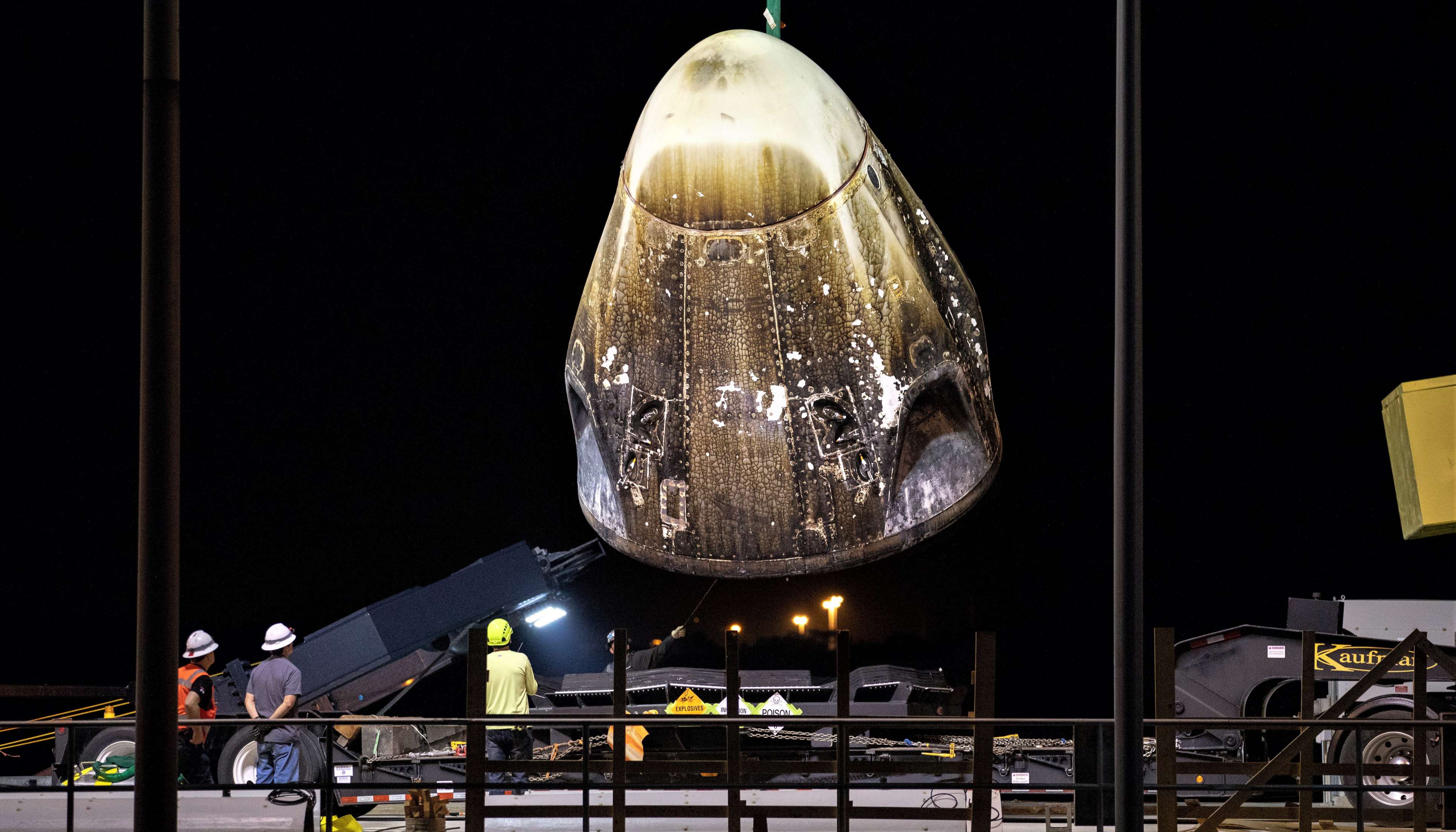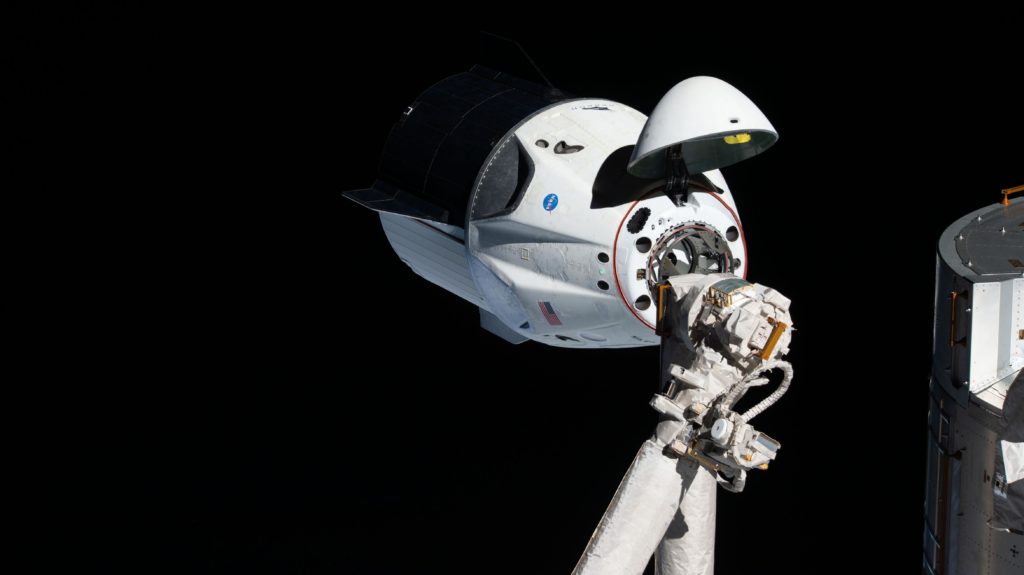

News
SpaceX’s Crew Dragon explosion investigation almost complete, says executive
Speaking at the 2019 AIAA Propulsion & Energy Forum, SpaceX Vice President of Build and Flight Reliability Hans Koenigsmann was significantly more confident that the company is just days or weeks away from wrapping up a serious Crew Dragon failure investigation.
On April 20th, flight-proven Crew Dragon capsule C201 experienced a catastrophic failure mode – largely a surprise to SpaceX – that completely destroyed the vehicle milliseconds prior to a planned static fire test. Given the obvious mortal danger such a failure would have posed to any crew aboard, SpaceX’s plans to conduct its first crewed Crew Dragon launch (Demo-2) in Q3 2019 were thrown out the window. Thankfully, Hans believes that SpaceX is just shy of concluding that investigation, “hopefully” permitting the launch of a critical abort test and Demo-2 before 2019 is out.
More specifically, Koenigsmann noted that SpaceX is currently planning to conduct a critical Crew Dragon in-flight abort (IFA) test in October or November, more or less in line with a recent report from NASASpaceflight.com that the test is targeted for November 11th, 2019. NASASpaceflight also confirmed that SpaceX still plans to fly Falcon 9 booster B1046.3 on the critical test flight, currently the only established plan to launch a thrice-flown booster, a potential first for SpaceX’s reusability program.
SpaceX’s IFA test is a continuation of the company’s suborbital Crew Dragon testing. Back in 2015, SpaceX successfully completed a pad abort test in which a low-fidelity Dragon mockup used its eight SuperDraco abort thrusters to replicate an escape from a rocket failure on the launch pad. SpaceX’s in-flight abort test will – like its namesake indicates – perform a similar test in flight, ensuring that Crew Dragon is able to safely escape from a failing Falcon 9 at Max Q, the point during launch where atmosphere-induced mechanical stress is at its peak.
In theory, demonstrating a successful pad and in-flight (Max Q) abort means that a given spacecraft is able to safely abort at all points during flight – from the pad all the way to orbit. It’s not clear if Crew Dragon is actually designed to be capable of what’s known as an “abort-to-orbit”, but the hardware is likely there if it’s needed.

On July 15th, Hans Koenigsmann and NASA Commercial Crew Program (CCP) manager Kathy Lueders went into significant detail with a preliminary Crew Dragon failure investigation update. They revealed that Crew Dragon’s April 20th explosion was traced to a likely mode, in which a “slug” of Dragon’s liquid oxidizer (nitrogen tetroxide, NTO) leaked and was subsequently smashed into a titanium valve by helium pressurized to several thousand PSI.
Said impact – effectively turning NTO into a bullet – thus created a spark in one or two ways: the titanium debris could have easily created sparks on its own, while NTO is also known to interact in violent and exotic ways with titanium under impact conditions. Either way, the fix is relatively simple (replace the valves and avoid titanium in the NTO pressurization system), but the fact that the design flaw existed in the first place serves as a much larger concern for the entirety of Crew Dragon’s joint SpaceX-NASA design and certification.
Ultimately, Hans seemed much more confident on August 19th than he was a month prior, indicating that the investigation is just shy of wrapping up. Once complete, SpaceX can complete the necessary modifications and get back on the saddle for Crew Dragon’s inaugural crewed launch and next abort test.
Check out Teslarati’s Marketplace! We offer Tesla accessories, including for the Tesla Cybertruck and Tesla Model 3.
News
Tesla begins Robotaxi certification push in Arizona: report
Tesla seems serious about expanding its Robotaxi service to several states in the coming months.

Tesla has initiated discussions with Arizona transportation regulators to certify its driverless Robotaxi service in the state, as per a recent report from Bloomberg News. The move follows Tesla’s launch of its Robotaxi pilot program in Austin, Texas, as well as CEO Elon Musk’s recent comments about the service’s expansion in the Bay Area.
The Arizona Department of Transportation confirmed to Bloomberg that Tesla has reached out to begin the certification process for autonomous ride-sharing operations in the state. While details remain limited, the outreach suggests that Tesla is serious about expanding its driverless Robotaxi service to several territories in the coming months.
The Arizona development comes as Tesla prepares to expand its service area in Austin this weekend, as per CEO Elon Musk in a post on X. Musk also stated that Tesla is targeting the San Francisco Bay Area as its next major market, with a potential launch “in a month or two,” pending regulatory approvals.
Tesla first launched its autonomous ride-hailing program on June 22 in Austin with a small fleet of Model Y vehicles, accompanied by a Tesla employee in the passenger seat to monitor safety. While still classified as a test, Musk has said the program will expand to about 1,000 vehicles in the coming months. Tesla will later upgrade its Robotaxi fleet with the Cyercab, a two-seater that is designed without a steering wheel.
Sightings of Cybercab castings around the Giga Texas complex suggests that Tesla may be ramping the initial trial production of the self-driving two-seater. Tesla, for its part, has noted in the past that volume production of the Cybercab is expected to start sometime next year.
In California, Tesla has already applied for a transportation charter-party carrier permit from the state’s Public Utilities Commission. The company is reportedly taking a phased approach to operating in California, with the Robotaxi service starting with pre-arranged rides for employees in vehicles with safety drivers.
News
Tesla sets November 6 date for 2025 Annual Shareholder Meeting
The automaker announced the date on Thursday in a Form 8-K.

Tesla has scheduled its 2025 annual shareholder meeting for November 6, addressing investor concerns that the company was nearing a legal deadline to hold the event.
The automaker announced the date on Thursday in a Form 8-K submitted to the United States Securities and Exchange Commission (SEC). The company also listed a new proposal submission deadline of July 31 for items to be included in the proxy statement.
Tesla’s announcement followed calls from a group of 27 shareholders, including the leaders of large public pension funds, which urged Tesla’s board to formally set the meeting date, as noted in a report from The Wall Street Journal.
The group noted that under Texas law, where Tesla is now incorporated, companies must hold annual meetings within 13 months of the last one if requested by shareholders. Tesla’s previous annual shareholder meeting was held on June 13, 2024, which placed the July 13 deadline in focus.
Tesla originally stated in its 2024 annual report that it would file its proxy statement by the end of April. However, an amended filing on April 30 indicated that the Board of Directors had not yet finalized a meeting date, at least at the time.
The April filing also confirmed that Tesla’s board had formed a special committee to evaluate certain matters related to CEO Elon Musk’s compensation plan. Musk’s CEO performance award remains at the center of a lengthy legal dispute in Delaware, Tesla’s former state of incorporation.
Due to the aftermath of Musk’s legal dispute about his compensation plan in Delaware, he has not been paid for his work at Tesla for several years. Musk, for his part, has noted that he is more concerned about his voting stake in Tesla than his actual salary.
At last year’s annual meeting, TSLA shareholders voted to reapprove Elon Musk’s compensation plan and ratified Tesla’s decision to relocate its legal domicile from Delaware to Texas.
Elon Musk
Grok coming to Tesla vehicles next week “at the latest:” Elon Musk
Grok’s rollout to Tesla vehicles is expected to begin next week at the latest.

Elon Musk announced on Thursday that Grok, the large language model developed by his startup xAI, will soon be available in Tesla vehicles. Grok’s rollout to Tesla vehicles is expected to begin next week at the latest, further deepening the ties between the two Elon Musk-led companies.
Tesla–xAI synergy
Musk confirmed the news on X shortly after livestreaming the release of Grok 4, xAI’s latest large language model. “Grok is coming to Tesla vehicles very soon. Next week at the latest,” Musk wrote in a post on social media platform X.
During the livestream, Musk and several members of the xAI team highlighted several upgrades to Grok 4’s voice capabilities and performance metrics, positioning the LLM as competitive with top-tier models from OpenAI and Google.
The in-vehicle integration of Grok marks a new chapter in Tesla’s AI development. While Tesla has long relied on in-house systems for autonomous driving and energy optimization, Grok’s integration would introduce conversational AI directly into its vehicles’ user experience. This integration could potentially improve customer interaction inside Tesla vehicles.
xAI and Tesla’s collaborative footprint
Grok’s upcoming rollout to Tesla vehicles adds to a growing business relationship between Tesla and xAI. Earlier this year, Tesla disclosed that it generated $198.3 million in revenue from commercial, consulting, and support agreements with xAI, as noted in a report from Bloomberg News. A large portion of that amount, however, came from the sale of Megapack energy storage systems to the artificial intelligence startup.
In July 2023, Musk polled X users about whether Tesla should invest $5 billion in xAI. While no formal investment has been made so far, 68% of poll participants voted yes, and Musk has since stated that the idea would be discussed with Tesla’s board.
-

 Elon Musk1 week ago
Elon Musk1 week agoTesla investors will be shocked by Jim Cramer’s latest assessment
-

 Elon Musk3 days ago
Elon Musk3 days agoElon Musk confirms Grok 4 launch on July 9 with livestream event
-

 Elon Musk14 hours ago
Elon Musk14 hours agoxAI launches Grok 4 with new $300/month SuperGrok Heavy subscription
-

 News7 days ago
News7 days agoTesla Model 3 ranks as the safest new car in Europe for 2025, per Euro NCAP tests
-

 Elon Musk2 weeks ago
Elon Musk2 weeks agoA Tesla just delivered itself to a customer autonomously, Elon Musk confirms
-

 Elon Musk1 week ago
Elon Musk1 week agoxAI’s Memphis data center receives air permit despite community criticism
-

 Elon Musk2 weeks ago
Elon Musk2 weeks agoTesla’s Omead Afshar, known as Elon Musk’s right-hand man, leaves company: reports
-

 News2 weeks ago
News2 weeks agoXiaomi CEO congratulates Tesla on first FSD delivery: “We have to continue learning!”



















